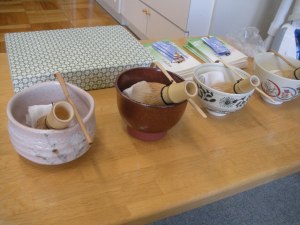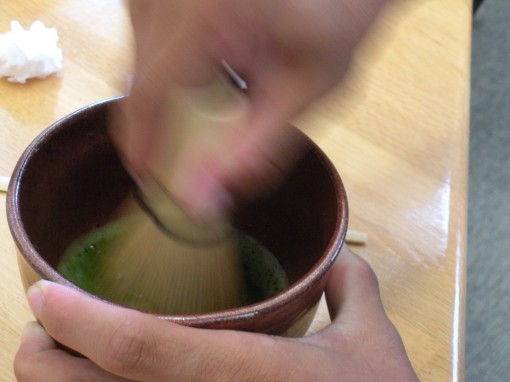 Today, I did a tea demonstration at a junior high school. The school had no tatami mat room, so we used three rolling platforms set up in the first years classroom. One of the teachers brought in a display of sumi-e that the students had done to hang up in the background.
Today, I did a tea demonstration at a junior high school. The school had no tatami mat room, so we used three rolling platforms set up in the first years classroom. One of the teachers brought in a display of sumi-e that the students had done to hang up in the background.
The theme of the demonstration was international cultural exchange, so I begin with talking to the students about how it was important to know your own culture, so then you will be able to share it with others who are interested. I also explained how Japanese culture has gained some popularity overseas and how the Daisosho and Oiemoto of Urasenke want to use to tea to spread understanding and peace throughout the world.
Next, I performed ryakubon temae. During this time the students just sat and watched, although I had one of the drink the tea I made. When speaking, I used only English, and asked the students to try to see what words they can hear. Personally, if you want to seriously study, it is important to learn Japanese. Even when I first started learning tea and didn’t speak a word of Japanese, I struggled and remembered phrases like “Osaki ni”, and “Otemae chodai itashimasu”. However, learning a foreign langauge is a rather high barrier, so for those studying tea casually, or for those who are just participating as a guest, we should use English, and make it easy to understand. Plus this demonstration was technically an English class.
After watching my temae, the students made pairs. I brought a bowl, chashaku, chasen, and chakin for each pair and kaishi for each student. Using the hot water from my tetsubin and from an electric kettle, they each served a sweet and made tea for each other.
The students all enjoyed the sweets. With the poetic name of “Uchimizu” (Scattered Water), I ordered them from a local sweetmaker called Rokkou.
Most of them like the matcha too. One of the students used four or five spoonfuls worth of tea in making tea for his partner, which was a little bitter, but over all it was great fun. At the end, the students were also able to make tea for the teachers there. Along with the teachers was one boy of about 6 years of age. His teacher told him the tea was “Karli Soup” (that’s my name), which was incredibly adorable. He drank up all his tea and said afterwards it was delicious. At then end, we had about 15 minutes left of the two hours scheduled for the demonstration, so the students helped wash the bowls, and straighten up.
After the demonstration, the students had school lunch. While originally I hadn’t intended to eat lunch with them, I was able to. School lunch was udon soup, which even when eaten with the utmost care tends to splatter. The science teacher recommended I wear one of the lab coats over my kimono. To my surprise, rather than being at awkward, it worked nicely!
It was a really wonderful experience, for both me and the students. It certainly wasn’t perfect. The utensils I possess are limited. I don’t have a furosaki and the only kettle I have is the tetsubin. We used a carpeted platform instead of proper tatami. But I feel that although the setting and materials might not be perfect, if you have an earnest love of tea and desire to share and create friendship in the world, you can truthfully communicate tea ceremony.
And a random kimono anecdote
One of my coworkers today joked he didn’t want to be in a picture with me in kimono. The reason was he wasn’t wearing a suit, only a polo shirt, and the formality of clothing would just be too unbalanced. Even worse, the polo shirt was from Uniqlo (a cheap clothing brand). If you are going to wear a polo shirt next to a kimono, it should at least be by Ralph Lauren.




January 23, 2014 at 11:10
I am interested in having a friend put on a kimono to perform a brief Japanese tea ceremony demonstration to a group of senior citizens. This would be part of a rally with a Japanese cherry blossom festival theme. We don’t have the proper utensils and will be getting by with substitute items. I just want the seniors to get a feel for the overall process by our explaining the meaning of the steps along the way. I was hoping we could witness a live demonstration before April 2014 but have not been successful locating one in Southern CA. We don’t have a budget to speak of so suggestions are appreciated. Your performing the demonstration to school students is similar to what we’d like to do for the seniors.
March 16, 2014 at 12:45
My response is rather late, and I can’t help you with locating any Tea ceremony demonstrations in America, but you can see a video of the temae portion of this demonstration here: http://www.youtube.com/watch?v=n-sMBMJQCTk
I really don’t think a high budget is necessary. For example, the iron kettle I am using here is not made for tea ceremony and just a cheap kettle from a hardware store that I use for everyday boiling of water.
You could replace the tray with a square of black fabric like chirimen, or even use a pretty thermos in place of the kettle/furo, as is often seen in nodate temae.
Anyway, the most important part is to convey the spirit of the tea ceremony I think. As long as you keep that close to your heart, I think that is enough. Good luck with your demonstration!